Holographic foil enhances your packaging or crafts with a vibrant, multidimensional shine that catches light and adds a high-tech, premium look, while plain foil offers a simple, reflective surface suited for classic and understated designs. Choosing holographic foil boosts visual impact and perceived value, whereas plain foil excels in subtle elegance and cost-effectiveness.
Table of Comparison
| Feature | Holographic Foil | Plain Foil |
|---|---|---|
| Visual Appeal | High-impact, multi-dimensional shine with shifting colors | Simple metallic shine, uniform appearance |
| Brand Differentiation | Enhances premium packaging, supports brand uniqueness | Standard look, minimal differentiation |
| Security Features | Acts as anti-counterfeit measure with complex patterns | No inherent security features |
| Cost | Higher production and material cost | Lower cost, budget-friendly option |
| Application | Used in luxury packaging, cosmetics, and limited editions | Common in food packaging, industrial use |
| Durability | Good resistance to wear but sensitive to scratches | Durable with consistent metal finish |
Introduction to Foil Finishes: Holographic vs Plain
Holographic foil features a multi-dimensional, light-reflective surface created through micro-embossing, producing vibrant rainbow effects that enhance visual appeal and attract consumer attention. Plain foil offers a smooth, metallic finish with a consistent color tone, providing a sleek and elegant look suitable for minimalist designs. Selecting between holographic and plain foil depends on the desired aesthetics, branding impact, and application context in packaging, printing, or decorative projects.
What Is Holographic Foil?
Holographic foil is a decorative material featuring a multi-dimensional, rainbow-like effect created through laser-etched micro-patterns that reflect light in vibrant colors. Unlike plain foil, which offers a single metallic sheen, holographic foil enhances packaging, printing, and crafting projects by adding dynamic visual interest and a premium look. Your designs gain a striking, eye-catching finish with holographic foil, making products stand out on shelves and attract customer attention.
Key Features of Plain Foil
Plain foil offers a smooth, reflective surface that enhances print clarity and foil adhesion, making it ideal for packaging and labeling applications. It provides consistent metallic shine without patterns, ensuring a sleek and professional finish. The foil's durability and heat resistance make it suitable for various embossing and hot stamping processes.
Visual Impact: Shimmer and Shine
Holographic foil creates a dynamic visual impact with its multidimensional shimmer and vibrant shine that shifts colors under different lighting, enhancing product appeal and consumer attraction. Plain foil offers a consistent metallic luster with a smooth, reflective surface that provides an elegant, subtle shine but lacks the color-shifting properties of holographic foil. Brands seeking eye-catching packaging often prefer holographic foil for its ability to stand out on shelves, while plain foil is chosen for a more classic, understated shimmer.
Durability and Longevity Comparison
Holographic foil exhibits superior durability compared to plain foil due to its multi-layered construction that resists scratching, fading, and peeling over time. The specialized coatings on holographic foil enhance its resistance to environmental factors such as moisture and UV exposure, ensuring longer-lasting visual appeal. In contrast, plain foil lacks these protective layers, making it more susceptible to wear and degradation under similar conditions.
Printing and Design Flexibility
Holographic foil offers superior printing and design flexibility through its ability to create vibrant, multidimensional effects that enhance visual appeal and brand differentiation. Unlike plain foil, which provides a uniform metallic finish, holographic foil incorporates intricate patterns and color shifts, allowing for dynamic customization and eye-catching packaging. This advanced printing capability supports complex graphics and fine details, making holographic foil the preferred choice for premium labeling and marketing materials.
Cost Analysis: Holographic vs Plain Foil
Holographic foil typically costs 30-50% more than plain foil due to its complex manufacturing process and eye-catching visual effects. While plain foil offers a budget-friendly option for basic packaging or decoration, holographic foil delivers premium branding impact that can justify the higher investment through enhanced customer appeal. Your choice should balance cost constraints with the desired aesthetic and marketing goals to maximize return on investment.
Best Use Cases for Each Foil Type
Holographic foil is ideal for luxury packaging, promotional materials, and event invitations where visual impact and eye-catching designs enhance brand appeal. Plain foil suits applications requiring a clean, elegant look, such as labels, certificates, and minimalist product packaging. Your choice depends on whether you want to emphasize intricate patterns and light reflection or maintain a straightforward, sophisticated appearance.
Environmental Considerations
Holographic foil typically involves complex manufacturing processes and the use of metalized layers, which can hinder recyclability and contribute to environmental waste compared to plain foil. Plain foil, often made from aluminum, is more widely recyclable and generally has a lower environmental footprint. Choosing plain foil supports streamlined recycling efforts and reduces the ecological impact linked to packaging materials.
Choosing the Right Foil for Your Project
Holographic foil offers vibrant, multi-dimensional effects that enhance product packaging, invitations, or promotional materials with eye-catching shine and texture, making it ideal for projects needing high visual impact. Plain foil provides a sleek, metallic finish with subtle elegance, perfect for minimalist designs and professional branding that require a polished but understated look. Choosing the right foil depends on your project's goal: use holographic foil to capture attention and create a dynamic appearance, while plain foil suits designs prioritizing simplicity and sophistication.
Holographic foil vs plain foil Infographic

 libmatt.com
libmatt.com